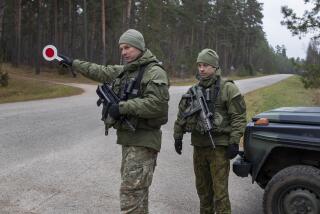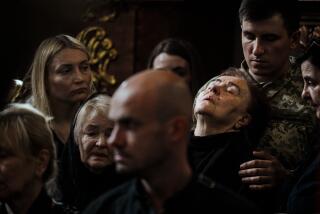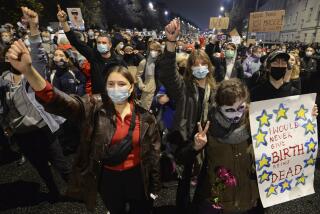On the Cutting Edge of Perestroika : Breathtaking Changes Sweep Baltic Republics
VILNIUS, Soviet Union — It was just another weekend in the new Lithuania.
Bodies of the late Vatslava Gujiene and 118 other postwar “enemies of the people” were finally brought back from Siberia, their place of exile, for reburial in their native soil. About 5,000 mourners, including Gujiene’s 56-year-old daughter, accompanied rough wooden coffins containing the remains of five exiles in a solemn procession from the medieval Holy City Gate to the newly restored Vilnius cathedral.
At the Palace of Culture of Construction Workers a few miles away, 600 delegates and invited guests took part in the founding congress of the new Lithuania Democratic Party. “We don’t stand for socialism with a human face,” explained an organizer. “We vote with both hands for democratic capitalism as a global system.”
Meanwhile, a demonstrator from the more radical Lithuanian Freedom League passed out what would only recently have been considered seditious literature and displayed a sign in English demanding “Stop Communism in Lithuania.”
Not far away, a Boy Scout sat at a small outdoor table near the statue of a Soviet general who “liberated” Lithuania, collecting signatures on a petition demanding that Moscow now remove its “occupation army” and let the Baltic people chose their own “socialist political order.”
And protester Nicholayas Tolpyginas pitched his tent on the front steps of the Communist Party’s vast, modern headquarters building, vowing neither to eat nor move until he is allowed to emigrate.
Asked what he thought about all these manifestations, the official who is theoretically Moscow’s man in Lithuania responded with a slightly nervous laugh. It just goes to show that “ours is the most democratic country in the world,” quipped Vladimir A. Beryozov, second secretary of the Lithuanian Communist Party.
“We don’t see here anything especially worrying,” he added in an interview. “On the one hand, of course, all sorts of consequences might ensue. But we feel that in our conditions, where for a long time we had no democracy, there is bound to be a certain degree of euphoria among people.”
Euphoria seems a gross understatement in describing what is happening throughout the Baltics these days. If the signs of change in Moscow are amazing, here they are breathtaking.
Estonia, Latvia and Lithuania represent the cutting edge of Soviet President Mikhail S. Gorbachev’s perestroika reform program. Just last week, the country’s reconstituted Supreme Soviet gave the Baltic republics preliminary approval to implement a degree of economic independence unprecedented since the earliest days of the Soviet state.
But the Baltics may also turn into perestroika’s most difficult test, because nowhere are the forces unleashed by Gorbachev’s reform program felt more powerfully than here on the northwestern edge of the Soviet empire.
Even as the Soviet Parliament was debating Baltic economic independence, about 100,000 Latvians took to the streets of Riga, the capital, demanding a multi-party political system.
In Estonia, ethnic Russian workers were on strike at several plants protesting what they described as discriminatory new laws with which the native majority hopes to drive them out of the republic.
To many Soviets, the Baltic people have long been a small but troublesome and ideologically unreliable minority. Estonia, Latvia and Lithuania were all independent “bourgeois” states between the two world wars, and they were the last of the Soviet Union’s 15 constituent republics to be annexed--in 1940.
Significant numbers here saw Nazi German troops as liberators at the time of Germany’s World War II attack on the Soviet Union, and bands of partisan guerrillas fought a losing battle against the Red Army into the early 1950s.
Now that Gorbachev and his fellow reformers are trying to work out a new relationship with all of the country’s republics, the Baltics are where the limits are being most seriously and regularly tested. Two months ago, popular fronts in Estonia, Latvia and Lithuania joined forces in a Baltic Assembly to coordinate action.
The developments are particularly eye-opening to a reporter who last visited Lithuania in the late 1970s, when the late Leonid I. Brezhnev was still in power and the Kremlin was most nervous about the impact in this predominantly Roman Catholic republic of a new, Polish Pope in the Vatican.
Lithuanians only talked to American reporters about their religion in a whisper then, even in their own homes.
Now Sunday Mass is broadcast on Lithuanian television.
The former Red Army Street and Komsomol Street are among dozens of Vilnius avenues whose names have been changed to honor Lithuanian--rather then Soviet--people and institutions.
The Soviet flag is nowhere to be seen, while the prewar yellow, green and red Lithuanian banner even flies over the republic’s Council of Ministers building.
There is a virtually free press in Lithuania today, with scores of independent newspapers available on every street corner. Many are published by regional branches of the popular Lithuanian reform movement, Sajudis.
The Sajudis Press Agency, organized two months ago to counter the alleged bias of the government news agency, is connected by telex and facsimile machine with newspaper, radio and television bureaus here and abroad.
Here, as elsewhere in the Baltics, history is a powerful force in the drive for fundamental change.
The petition the Boy Scout was asking people to sign demands renunciation of the 1939 Nazi-Soviet Nonaggression Pact, whose secret protocols assigned the Baltics to the Soviet Union. It would be a pivotal symbolic act, discrediting the basis on which the Kremlin annexed the three republics, and more than 600,000 people have reportedly signed the petition.
Asked whether there would be a demonstration here Aug. 23, the 50th anniversary of the pact, a woman collecting signatures at another location smiled coyly. “A meeting,” she corrected. “A big meeting. All Lithuania.”
The weekend’s emotional procession of mourners was a reminder of another painful episode in Soviet relations with the Baltics--the exile and imprisonment of hundreds of thousands of natives ordered by the dictator Josef Stalin.
Vatslava Gujiene’s crime, according to her daughter, was “to be a wealthy farmer and to live better than others”--a kulak in Russian revolutionary terms.
The entire family was arrested in 1948, the daughter, Zhekene Neyole, said. Her father died in prison, while she, her mother and four siblings were exiled to the Siberian town of Igarka. Her mother died there two years later of starvation.
And Neyole said she wasn’t free to return to Lithuania until the 1950s.
Now Moscow has given permission for the remains of Baltics exiles who died in Siberia to be returned for reburial. The first 119 were flown back to Lithuania on a military transport plane Friday.
The organizers of the new Lithuanian Democratic Party think that by allowing these activities, the Communist Party is trying to create what one called “the illusion of independent state.”
Still, the party’s founding congress was in itself another challenge to the limits of change. Gorbachev has made it clear that he has no intention of allowing a multiparty system.
Here in Lithuania, however, the rule is that “everything not directly forbidden is allowed,” said Egidijus Meilunas, a democratic party organizer.
Where it all may lead is unclear. The Baltic Assembly, at its first meeting last May, expressed its goal: “Self-determination and independence in a neutral and demilitarized zone of Europe.”
Others argue that the economies of the three republics are by now far too intergrated with the rest of the Soviet Union for a total break.
While the Baltics contain only about 8 million of the nation’s 280 million people and only about 1% of total Soviet terrority, the precedents set in these three republics will inevitably reverberate not only through the other 12 republics but also through Eastern Europe.
More to Read
Sign up for Essential California
The most important California stories and recommendations in your inbox every morning.
You may occasionally receive promotional content from the Los Angeles Times.










